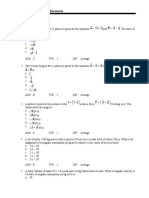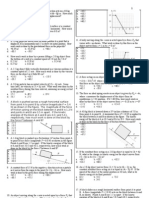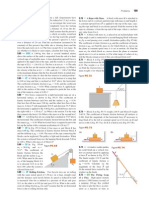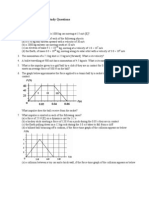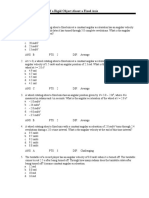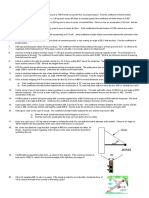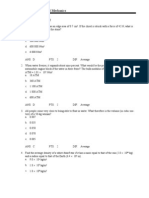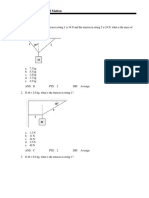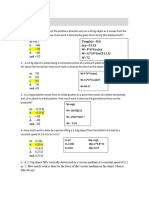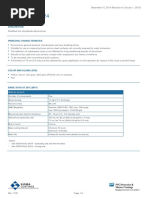TB Chapter7 PDF
TB Chapter7 PDF
Uploaded by
Asmaa AhmedCopyright:
Available Formats
TB Chapter7 PDF
TB Chapter7 PDF
Uploaded by
Asmaa AhmedOriginal Title
Copyright
Available Formats
Share this document
Did you find this document useful?
Is this content inappropriate?
Copyright:
Available Formats
TB Chapter7 PDF
TB Chapter7 PDF
Uploaded by
Asmaa AhmedCopyright:
Available Formats
Chapter 7
Energy and Energy Transfer
Multiple Choice
1.
A constant force of 12 N in the positive x direction acts on a 4.0-kg object as it
moves from the origin to the point ( 6 i 8 j ) m. How much work is done by the
given force during this displacement?
a.
b.
c.
d.
e.
2.
A 5.0-kg object is pulled along a horizontal surface at a constant speed by a 15-N
force acting 20 above the horizontal. How much work is done by this force as
the object moves 6.0 m?
a.
b.
c.
d.
e.
3.
78 J
82 J
85 J
74 J
43 J
A 2.0-kg projectile moves from its initial position to a point that is displaced 20 m
horizontally and 15 m above its initial position. How much work is done by the
gravitational force on the projectile?
a.
b.
c.
d.
e.
4.
+60 J
+84 J
+72 J
+48 J
+57 J
+0.29 kJ
0.29 kJ
+30 J
30 J
50 J
How much work is done by a person lifting a 2.0-kg object from the bottom of a
well at a constant speed of 2.0 m/s for 5.0 s?
a.
b.
c.
d.
e.
0.22 kJ
0.20 kJ
0.24 kJ
0.27 kJ
0.31 kJ
115
116
5.
CHAPTER 7
A 2.5-kg object falls vertically downward in a viscous medium at a constant
speed of 2.5 m/s. How much work is done by the force the viscous medium
exerts on the object as it falls 80 cm?
a.
b.
c.
d.
e.
6.
A 2.0-kg particle has an initial velocity of (5 i 4 j) m/s. Some time later, its
velocity is 7 i + 3j m/s. How much work was done by the resultant force during
this time interval, assuming no energy is lost in the process?
a.
b.
c.
d.
e.
7.
+2.0 J
+20 J
2.0 J
20 J
+40 J
17 J
49 J
19 J
53 J
27 J
A block is pushed across a rough horizontal surface from point A to point B by a
force (magnitude P = 5.4 N) as shown in the figure. The magnitude of the force of
friction acting on the block between A and B is 1.2 N and points A and B are
0.5 m apart. If the kinetic energies of the block at A and B are 4.0 J and 5.6 J,
respectively, how much work is done on the block by the force P between A and
B?
P
A
a.
b.
c.
d.
e.
8.
2.7 J
1.0 J
2.2 J
1.6 J
3.2 J
A constant force of 15 N in the negative y direction acts on a particle as it moves
from the origin to the point (3i + 3j 1k ) m. How much work is done by the
given force during this displacement?
a.
b.
c.
d.
e.
+45 J
45 J
+30 J
30 J
+75 J
Energy and Energy Transfer
9.
117
An object moving along the x axis is acted upon by a force Fx that varies with
position as shown. How much work is done by this force as the object moves
from x = 2 m to x = 8 m?
Fx (N)
20
10
0
10 12
x (m)
10
a.
b.
c.
d.
e.
10.
10 J
+10 J
+30 J
30 J
+40 J
A body moving along the x axis is acted upon by a force Fx that varies with x as
shown. How much work is done by this force as the object moves from x = 1 m to
x = 8 m?
Fx (N)
4
0
x (m)
4
8
a.
b.
c.
d.
e.
11.
2 J
18 J
10 J
26 J
+18 J
A force acting on an object moving along the x axis is given by
Fx = (14x 3.0x2) N
where x is in m. How much work is done by this force as the object moves from
x = 1 m to x = +2 m?
a.
b.
c.
d.
e.
+12 J
+28 J
+40 J
+42 J
28 J
118
12.
CHAPTER 7
The force an ideal spring exerts on an object is given by Fx = kx, where x
measures the displacement of the object from its equilibrium (x = 0) position. If
k = 60 N/m, how much work is done by this force as the object moves from
x = 0.20 m to x = 0?
a.
b.
c.
d.
e.
13.
1.2 J
+1.2 J
+2.4 J
2.4 J
+3.6 J
A 4.0-kg block is lowered down a 37 incline a distance of 5.0 m from point A to
point B. A horizontal force (F = 10 N) is applied to the block between A and B as
shown in the figure. The kinetic energy of the block at A is 10 J and at B it is 20 J.
How much work is done on the block by the force of friction between A and B?
A
F
37
37
37
37
a.
b.
c.
d.
e.
14.
58 J
53 J
68 J
63 J
47 J
If the resultant force acting on a 2.0-kg object is equal to (3i + 4 j) N, what is the
change in kinetic energy as the object moves from (7 i 8 j) m to (11i 5 j) m?
a.
b.
c.
d.
e.
15.
+36 J
+28 J
+32 J
+24 J
+60 J
As a 2.0-kg object moves from (2 i + 5 j) m to (6 i 2 j) m, the constant resultant
force acting on it is equal to 4 i 3j) N. If the speed of the object at the initial
position is 4.0 m/s, what is its kinetic energy at its final position?
a.
b.
c.
d.
e.
62 J
53 J
73 J
86 J
24 J
Energy and Energy Transfer
16.
119
A block slides on a rough horizontal surface from point A to point B. A force
(magnitude P = 2.0 N) acts on the block between A and B, as shown. Points A
and B are 1.5 m apart. If the kinetic energies of the block at A and B are 5.0 J and
4.0 J, respectively, how much work is done on the block by the force of friction as
the block moves from A to B?
P
40
40
a.
b.
c.
d.
e.
17.
3.3 J
+1.3 J
+3.3 J
1.3 J
+4.6 J
A 2.0-kg block slides down a frictionless incline from point A to point B. A force
(magnitude P = 3.0 N) acts on the block between A and B, as shown. Points A
and B are 2.0 m apart. If the kinetic energy of the block at A is 10 J, what is the
kinetic energy of the block at B?
A
30
30
a.
b.
c.
d.
e.
27 J
20 J
24 J
17 J
37 J
120
18.
CHAPTER 7
A 3.0-kg block is dragged over a rough horizontal surface by a constant force of
16 N acting at an angle of 37 above the horizontal as shown. The speed of the
block increases from 4.0 m/s to 6.0 m/s in a displacement of 5.0 m. What work
was done by the friction force during this displacement?
16 N
37
30
a.
b.
c.
d.
e.
19.
A 6.0-kg block slides along a horizontal surface. If k = 0.20 for the block and
surface, at what rate is the friction force doing work on the block at an instant
when its speed is 4.0 m/s?
a.
b.
c.
d.
e.
20.
59 W
47 W
71 W
82 W
+71 W
At what rate is the gravitational force on a 2.0-kg projectile doing work at an
instant when the velocity of the projectile is 4.0 m/s directed 30 above the
horizontal?
a.
b.
c.
d.
e.
21.
34 J
64 J
30 J
94 J
+64 J
+39 W
78 W
39 W
+78 W
+25 W
A 2.0-kg block slides down a plane (inclined at 40 with the horizontal) at a
constant speed of 5.0 m/s. At what rate is the gravitational force on the block
doing work?
a.
b.
c.
d.
e.
+98 W
+63 W
zero
+75 W
75 W
Energy and Energy Transfer
22.
The speed of a 4.0-kg object is given by v = (2t) m/s, where t is in s. At what rate
is the resultant force on this object doing work at t = 1 s?
a.
b.
c.
d.
e.
23.
+28 W
+13 W
13 W
28 W
+6.5 W
A 3.0-kg block is on a horizontal surface. The block is at rest when, at t = 0, a
force (magnitude P = 12 N) acting parallel to the surface is applied to the block
causing it to accelerate. The coefficient of kinetic friction between the block and
the surface is 0.20. At what rate is the force P doing work on the block at t = 2.0 s?
a.
b.
c.
d.
e.
26.
2.3 W
2.0 W
1.4 W
1.7 W
1.2 W
A 1.6-kg block slides down a plane (inclined at 25 with the horizontal) at a
constant speed of 2.0 m/s. At what rate is the frictional force doing work on the
block?
a.
b.
c.
d.
e.
25.
48 W
40 W
32 W
56 W
16 W
A 3.0-kg block is on a frictionless horizontal surface. The block is at rest when, at
t = 0, a force (magnitude P = 2.0 N) acting at an angle of 22 above the horizontal
is applied to the block. At what rate is the force P doing work at t = 2.0 s?
a.
b.
c.
d.
e.
24.
121
54 W
49 W
44 W
59 W
24 W
Starting from rest at t = 0, a 5.0-kg block is pulled across a horizontal surface by a
constant horizontal force having a magnitude of 12 N. If the coefficient of friction
between the block and the surface is 0.20, at what rate is the 12-N force doing
work at t = 5.0 s?
a.
b.
c.
d.
e.
0.13 kW
0.14 kW
0.12 kW
26 W
12 W
122
27.
CHAPTER 7
A 10-kg block on a horizontal frictionless surface is attached to a light spring
(force constant = 0.80 kN/m). The block is initially at rest at its equilibrium
position when a force (magnitude P = 80 N) acting parallel to the surface is
applied to the block, as shown. What is the speed of the block when it is 13 cm
from its equilibrium position?
a.
b.
c.
d.
e.
28.
0.85 m/s
0.89 m/s
0.77 m/s
0.64 m/s
0.52 m/s
A 10-kg block on a horizontal frictionless surface is attached to a light spring
(force constant = 1.2 kN/m). The block is initially at rest at its equilibrium
position when a force (magnitude P) acting parallel to the surface is applied to
the block, as shown. When the block is 8.0 cm from the equilibrium position, it
has a speed of 0.80 m/s. How much work is done on the block by the force P as
the block moves the 8.0 cm?
a.
b.
c.
d.
e.
8.3 J
6.4 J
7.0 J
7.7 J
3.9 J
Energy and Energy Transfer
29.
A 20-kg block on a horizontal surface is attached to a light spring
(force constant = 8.0 kN/m). The block is pulled 10 cm to the right from its
equilibrium position and released from rest. When the block has moved 2.0 cm
toward its equilibrium position, its kinetic energy is 13 J. How much work is
done by the frictional force on the block as it moves the 2.0 cm?
a.
b.
c.
d.
e.
30.
123
2.5 J
1.4 J
3.0 J
1.9 J
14 J
The horizontal surface on which the block slides is frictionless. The speed of the
block before it touches the spring is 6.0 m/s. How fast is the block moving at the
instant the spring has been compressed 15 cm? k = 2.0 kN/m
v
k
2.0 kg
a.
b.
c.
d.
e.
31.
3.7 m/s
4.4 m/s
4.9 m/s
5.4 m/s
14 m/s
A 2.0-kg block situated on a frictionless incline is connected to a light spring
(k = 100 N/m), as shown. The block is released from rest when the spring is
unstretched. The pulley is frictionless and has negligible mass. What is the speed
of the block when it has moved 0.20 m down the plane?
k
37
37
a.
b.
c.
d.
e.
76 cm/s
68 cm/s
60 cm/s
82 cm/s
57 cm/s
124
32.
CHAPTER 7
A 2.0-kg block sliding on a frictionless horizontal surface is attached to one end
of a horizontal spring (k = 600 N/m) which has its other end fixed. The speed of
the block when the spring is extended 20 cm is equal to 3.0 m/s. What is the
maximum speed of this block as it oscillates?
a.
b.
c.
d.
e.
33.
A 10-kg block on a rough horizontal surface is attached to a light spring
(force constant = 1.4 kN/m). The block is pulled 8.0 cm to the right from its
equilibrium position and released from rest. The frictional force between the
block and surface has a magnitude of 30 N. What is the kinetic energy of the
block as it passes through its equilibrium position?
a.
b.
c.
d.
e.
34.
4.5 J
2.1 J
6.9 J
6.6 J
4.9 J
A 2.0-kg body moving along the x axis has a velocity vx = 5.0 m/s at x = 0. The
only force acting on the object is given by Fx = (4.0x) N, where x is in m. For
what value of x will this object first come (momentarily) to rest?
a.
b.
c.
d.
e.
35.
4.6 m/s
5.3 m/s
5.7 m/s
4.9 m/s
3.5 m/s
4.2 m
3.5 m
5.3 m
6.4 m
5.0 m
A 1.5-kg object moving along the x axis has a velocity of +4.0 m/s at x = 0. If the
only force acting on this object is shown in the figure, what is the kinetic energy
of the object at x = +3.0 m?
Fx (N)
8
4
0
a.
b.
c.
d.
e.
18 J
21 J
23 J
26 J
8J
x (m)
Energy and Energy Transfer
36.
125
The only force acting on a 1.6-kg body as it moves along the x axis is given in the
figure. If the velocity of the body at x = 2.0 m is 5.0 m/s, what is its kinetic energy
at x = 5.0 m?
Fx (N)
8
4
0
x (m)
4
8
a.
b.
c.
d.
e.
37.
The only force acting on a 2.0-kg body moving along the x axis is given by
Fx = (2.0x) N, where x is in m. If the velocity of the object at x = 0 is +3.0 m/s,
how fast is it moving at x = 2.0 m?
a.
b.
c.
d.
e.
38.
4.2 m/s
3.6 m/s
5.0 m/s
5.8 m/s
2.8 m/s
The only force acting on a 2.0-kg body as it moves along the x axis is given by
Fx = (12 2.0x) N, where x is in m. The velocity of the body at x = 2.0 m is
5.5i m/s. What is the maximum kinetic energy attained by the body?
a.
b.
c.
d.
e.
39.
52 J
44 J
36 J
60 J
25 J
36 J
39 J
43 J
46 J
30 J
The only force acting on a 1.8-kg body as it moves along the x axis is given by
Fx = (3.0x) N, where x is in m. If the velocity of the body at x = 0 is vx = +8.0 m/s,
at what value of x will the body have a velocity of +4.0 m/s?
a.
b.
c.
d.
e.
5.7 m
5.4 m
4.8 m
4.1 m
6.6 m
126
40.
CHAPTER 7
Two vectors A and B are given by A = 5 i + 6 j + 7 k and B = 3i 8 j + 2 k . If these
two vectors are drawn starting at the same point, what is the angle between
them?
a.
b.
c.
d.
e.
41.
If A = 7 i 6 j + 5 k , | B |= 7 , and the angle between A and B (when the two are
drawn starting from the same point) is 60, what is the scalar product of these
two vectors?
a.
b.
c.
d.
e.
42.
76
62
90
47
170
If the vectors A and B have magnitudes of 10 and 11, respectively, and the
scalar product of these two vectors is 100, what is the magnitude of the sum of
these two vectors?
a.
b.
c.
d.
e.
44.
13
+13
+37
37
73
If vectors A and B have magnitudes 12 and 15, respectively, and the angle
between the two when they are drawn starting from the same point is 110, what
is the scalar product of these two vectors?
a.
b.
c.
d.
e.
43.
106
102
110
113
97
6.6
4.6
8.3
9.8
7.6
If the scalar product of two vectors, A and C , is equal to 3.5, if A = 2.0 , and the
angle between the two vectors when they are drawn starting from the same point
is equal to 130, what is the magnitude of C ?
a.
b.
c.
d.
e.
2.1
2.5
2.3
2.7
3.1
Energy and Energy Transfer
45.
If A C = 7.5 , A = 3i 4 j , and | C |= 6.5 , what is the angle between the two vectors
when they are drawn starting from the same point?
118
107
112
103
77
a.
b.
c.
d.
e.
46.
Two vectors A and B are given by A = 4 i + 8 j and B = 6 i 2 j . The scalar product
of A and a third vector C is 16. The scalar product of B and C is +18. The z
component of C is 0. What is the magnitude of C ?
a.
b.
c.
d.
e.
47.
127
7.8
6.4
3.6
5.0
4.8
If A = 10, B = 15, and = 130, determine the scalar product of the two vectors
shown.
a.
b.
c.
d.
e.
48.
+96
96
+51
51
35
If A = 5.0, B = 8.0, and = 30, determine the scalar product of the two vectors
shown.
B
a.
b.
c.
d.
e.
35
+35
20
+20
+40
128
49.
CHAPTER 7
If A = 6.0, B = 5.0, and = 40, determine the scalar product of the two vectors
shown.
A
a.
b.
c.
d.
e.
50.
51.
The same constant force is used to accelerate two carts of the same mass, initially
at rest, on horizontal frictionless tracks. The force is applied to cart A for twice as
long a time as it is applied to cart B. The work the force does on A is WA; that on
B is WB. Which statement is correct?
a.
WA = WB.
b.
c.
d.
e.
WA = 2 WB.
WA = 2 WB.
WA = 4 WB.
WB = 2WA.
Carts A and B have equal masses and travel equal distances on straight
frictionless tracks while a constant force F is applied to A, and a constant force 2F
is applied to B. The relative amounts of work done by the two forces are related
by
a.
b.
c.
d.
e.
52.
+19
+23
19
23
+30
WA = 4 WB.
WA = 2 WB.
WA = WB.
WB = 2 WA.
WB = 4 WA.
Carts A and B have equal masses and travel equal distances D on side-by-side
straight frictionless tracks while a constant force F acts on A and a constant force
2F acts on B. Both carts start from rest. The velocities vA and vB of the bodies at
the end of distance D are related by
a.
b.
c.
d.
e.
vB = vA.
vB = 2 vA.
vB = 2 vA.
vB = 4 vA.
vA = 2vB.
Energy and Energy Transfer
53.
Two equal masses are raised at constant velocity by ropes that run over pulleys,
as shown below. Mass B is raised twice as fast as mass A. The magnitudes of the
forces are FA and FB, while the power supplied is respectively PA and PB. Which
statement is correct ?
a.
b.
c.
d.
e.
54.
FB = FA; PB = PA.
FB = FA; PB = 2 PA.
FB = 2 FA; PB = PA.
FB = 2 FA; PB = 2 PA.
PA = FA; PB = FB.
When a ball rises vertically to a height h and returns to its original point of
projection, the work done by the gravitational force is
a.
b.
c.
d.
e.
55.
129
0.
mgh .
+mgh.
2mgh.
+2mgh.
When a crate of mass m is dragged a distance d along a surface with coefficient of
kinetic friction k , then dragged back along the same path to its original
position, the work done by friction is
a.
b.
0.
k mgd .
c.
+ k mgd .
d.
2 k mgd .
e.
+2 k mgd .
130
56.
CHAPTER 7
Two balls, A and B, of mass m and 2m respectively, are carried to height h at
constant velocity, but B rises twice as fast as A. The work the gravitational force
does on B is
a.
b.
c.
d.
e.
57.
58.
Equal amounts of work are performed on two bodies, A and B, initially at rest,
and of masses M and 2M respectively. The relation between their speeds
immediately after the work has been done on them is
a.
b.
c.
v A = 2v B .
v A = 2v B .
v A = vB .
d.
e.
v B = 2v A .
v B = 2v A .
Two cannonballs are dropped from a second floor physics lab at height h above
the ground. Ball B has four times the mass of ball A. When the balls pass the
h
bottom of a first floor window at height
above the ground, the relation
4
between their kinetic energies, K A and K B is
a.
b.
c.
d.
e.
59.
one quarter the work done on A.
one half the work done on A.
the same as the work done on A.
twice the work done on A.
four times the work done on A.
K A = 4K B .
K A = 2K B .
K A = KB .
K B = 2K A .
K B = 4K A .
Two clowns are launched from the same spring-loaded circus cannon with the
spring compressed the same distance each time. Clown A has a 40-kg mass;
clown B a 60-kg mass. The relation between their kinetic energies at the instant of
launch is
c.
3
KB .
2
3
KA =
KB .
2
K A = KB .
d.
KB =
e.
KB =
a.
b.
KA =
3
KA .
2
3
KA .
2
Energy and Energy Transfer
60.
Two clowns are launched from the same spring-loaded circus cannon with the
spring compressed the same distance each time. Clown A has a 40-kg mass;
clown B a 60-kg mass. The relation between their speeds at the instant of launch
is
c.
3
vB .
2
3
vA =
vB .
2
v A = vB .
d.
vB =
e.
vB =
a.
b.
61.
3
vA .
2
3
vA .
2
Block A has twice as much kinetic energy as block B.
Block B has lost twice as much kinetic energy to friction as block A.
Block B has lost twice as much kinetic energy as block A.
Both blocks have had equal losses of energy to friction.
No energy is lost to friction because the ground has no displacement.
If the scalar (dot) product of two vectors is negative, it means that
a.
b.
c.
d.
e.
63.
vA =
In a contest, two tractors pull two identical blocks of stone the same distance
over identical surfaces. However, block A is moving twice as fast as block B
when it crosses the finish line. Which statement is correct?
a.
b.
c.
d.
e.
62.
131
there was a calculator error.
the angle between the vectors is less than 90 degrees.
the angle between the vectors is 90 degrees.
the angle between the vectors is greater than 270 degrees.
the angle between the vectors is between 90 and 180 degrees.
Two eggs of equal mass are thrown at a blanket with equal velocity. Egg B hits
the blanket but egg A hits the wall instead. Compare the work done on the eggs
in reducing their velocities to zero.
a.
b.
c.
d.
e.
More work was done on A than on B.
More work was done on B than on A.
The amount of work is the same for both.
It is meaningless to compare the amount of work because the forces were so
different.
Work was done on B, but no work was done on A because the wall did not
move.
132
64.
CHAPTER 7
Planets go around the sun in elliptical orbits. The highly exaggerated diagram
below shows a portion of such an orbit and the force on the planet at one
position along that orbit. The planet is moving to the right. F|| and F are the
components of the force parallel (tangential) and perpendicular (normal) to the
orbit. The work they do is W|| and W. At the position shown
v
a.
b.
c.
d.
e.
65.
A mass attached to the end of a spring is pulled out and released on a surface
with friction. The work Fsp dx done on the mass by the force exerted by the
spring
a.
b.
c.
d.
e.
66.
never has the same sign as the change in energy owing to friction.
always has the same sign as the change in energy owing to friction.
has the same sign as the change in energy owing to friction during one half
of each cycle.
never has the same sign as the change in energy owing to friction if the force
of friction is greater than the spring force.
always has the same sign as the change in energy owing to friction if the
force of friction is greater than the spring force.
The work Fsp dx done by the force exerted by the spring on a mass attached to
the end of the spring when the mass has displacement dx is
a.
b.
c.
d.
e.
67.
W|| slows the planet down; W speeds it up.
W|| slows the planet down; W does no work on it.
W|| speeds the planet up; W does no work on it.
W|| speeds the planet up; W slows it down.
W|| does no work on it; W speeds the planet up.
always negative.
always positive.
negative half the time, positive the other half of the time.
positive more than it is negative.
negative more than it is positive.
A 30 kg child sitting 5.0 m from the center of a merry-go-round has a constant
speed of 5.0 m/s. While she remains seated in the same spot and travels in a
circle, the work the seat performs on her in one complete rotation is
a.
b.
c.
d.
e.
0 J.
150 J.
1500 J.
4700 J.
46,000 J.
Energy and Energy Transfer
68.
Sally, who weighs 450 N, stands on a skate board while Roger pushes it forward
13.0 m at constant velocity on a level straight street. He applies a constant 100 N
force.
a.
b.
c.
d.
e.
69.
b.
c.
d.
e.
c.
d.
e.
by friction while a car is accelerating without skidding.
by a spring at the bottom of an elevator shaft when it stops a falling
elevator.
by a hand catching a ball.
by all of the above.
only by (b) and (c) above.
Positive work can be done
a.
b.
c.
d.
e.
72.
Hakim, because the diving board is deformed and vibrated like a spring
when Roger jumps.
Ludmilla, because Roger jumps up in the air above the diving board.
Neither, because Rogers muscles do all the work.
Both, because Rogers muscles do all the work.
Neither, because the diving board does all the work.
Negative work can be done
a.
b.
71.
The work Roger does on the skateboard is 0 J.
The work Roger does on the skateboard is 1300 J.
The work Sally does on the skateboard is 1300 J.
The work Sally does on the skateboard is 5850 J.
The work Roger does on the skateboard is 5850 J.
After jumping up and down on a diving board, Roger jumps off the diving
board. Hakim claims that Roger does work on the diving board because he
supplies energy to it. Ludmilla claims that the diving board does work on Roger
and supplies energy to him. Which one, if either, is correct?
a.
70.
133
by friction when a car is accelerating without skidding.
by a spring when it launches a clown in the air.
by a hand throwing a ball.
by all of the above.
only by (b) and (c) above.
The force of static friction exerted on an automobiles tires by the ground
a.
b.
c.
d.
e.
provides the accelerating force that makes the car move forward.
does positive work on the car while it is accelerating.
does negative work on the car while it is decelerating.
does everything listed in (a), (b) and (c).
only does positive or negative work as in (b) or (c).
134
73.
CHAPTER 7
The graph below shows how the force on a 0.500 kg particle varies with position.
If the particle has speed v = 2.23
x = 8.00 m?
m
at x = 2.00 m, what is its speed in m/s when
s
Force vs Position
12
10
8
6
4
2
0
0
10
12
x (m)
a.
b.
c.
d.
e.
74.
2.00
10.7
14.8
15.0
21.1
The equation below is the solution to a physics problem:
2
2
1
m 1
m
m
(2.30 kg) 5.00 = (2.30 kg)2.33 + (2.30 kg) 9.80 2 (1.00 m)cos(60) .
2
s 2
s
s
The most likely physical situation it describes is
a.
b.
c.
d.
e.
a 2.30 kg cart rolling up a 30 incline.
a 2.30 kg cart rolling down a 30 incline.
a 2.30 kg cart rolling up a 60 incline.
a 2.30 kg cart rolling down a 60 incline.
a 2.30 kg cart rolling down a 90 incline.
Energy and Energy Transfer
75.
135
A compressed spring is used to launch a skier up an icy ski slope with a 20
incline. How far up the incline the skier travels may depend on the following
factors:
I.
the skiers mass.
II.
how far the spring is compressed.
III.
the force constant of the spring
IV.
the angle of incline of the slope.
V.
the value of the gravitational constant g at that location.
To find the distance up the slope we do not need to know
a.
b.
c.
d.
e.
76.
I.
II.
III.
IV.
V.
After a skydiver reaches terminal velocity,
a.
b.
c.
d.
e.
the force of gravity no longer performs work on the skydiver.
work performed by the force of gravity is converted into gravitational
potential energy.
gravitational potential energy is no longer available to the system of the
skydiver plus the Earth.
gravitational potential energy is converted into thermal energy.
thermal energy is converted into gravitational potential energy.
Open-Ended Problems
77.
While running, a person dissipates about 0.6 J of mechanical energy per step per
kilogram of body mass. If a 60-kg person runs with a power of 70 Watts during a
race, how fast is the person running? Assume a running step is 1.5 m long.
78.
A baseball outfielder throws a baseball of mass 0.15 kg at a speed of 40 m/s and
initial angle of 30. What is the kinetic energy of the baseball at the highest point
of the trajectory?
79.
When an automobile moves with constant velocity the power developed is used
to overcome the frictional forces exerted by the air and the road. If the power
developed in an engine is 50.0 hp, what total frictional force acts on the car at
55 mph (24.6 m/s)? One horsepower equals 746 W.
136
CHAPTER 7
Energy and Energy Transfer
Chapter 7
Energy and Energy Transfer
1.
31.
2.
32.
3.
33.
4.
34.
5.
35.
6.
36.
7.
37.
8.
38.
9.
39.
10.
40.
11.
41.
12.
42.
13.
43.
14.
44.
15.
45.
16.
46.
17.
47.
18.
48.
19.
49.
20.
50.
21.
51.
22.
52.
23.
53.
24.
54.
25.
55.
26.
56.
27.
57.
28.
58.
29.
59.
30.
60.
137
138
CHAPTER 7
61.
62.
63.
64.
65.
66.
67.
68.
69.
70.
71.
72.
73.
74.
75.
76.
77.
2.92 m/s
78.
90 J
79.
1520 N
You might also like
- Testbank Chapter09Document20 pagesTestbank Chapter09AldrianYanesa100% (1)
- STJLR 51 5254Document7 pagesSTJLR 51 5254akomocar100% (1)
- Physics MC Forces Newtons LawsDocument31 pagesPhysics MC Forces Newtons LawsT W100% (1)
- Chapter 5 PDFDocument34 pagesChapter 5 PDFQassem MohaidatNo ratings yet
- Exam2 S12 SolutionsDocument14 pagesExam2 S12 SolutionsMeyer WolfsheimNo ratings yet
- Wolfson Eup3 ch09 Test BankDocument15 pagesWolfson Eup3 ch09 Test Bank陳禹誌No ratings yet
- Testbank Chapter15Document11 pagesTestbank Chapter15AnaMendezNo ratings yet
- Chapter 11-Angular Momentum: Multiple ChoiceDocument16 pagesChapter 11-Angular Momentum: Multiple ChoiceMarcial Aguilar BarahonaNo ratings yet
- Chapter 3 Motion in 2DDocument7 pagesChapter 3 Motion in 2Dbmz00000No ratings yet
- PSE 9e CH 24 CH 25 26 Combined SerwayDocument60 pagesPSE 9e CH 24 CH 25 26 Combined SerwayYaas BahNo ratings yet
- As Newtons Laws and Momentum QuestionsDocument61 pagesAs Newtons Laws and Momentum Questionshasan_shahryar2008No ratings yet
- Chemical Tanker SafetyDocument43 pagesChemical Tanker SafetyVitalie Fricatel100% (6)
- Trabajo y EnergíaDocument5 pagesTrabajo y EnergíaEve ParedesNo ratings yet
- Get Physics for Scientists and Engineers 9th Edition Serway Test Bank free all chaptersDocument57 pagesGet Physics for Scientists and Engineers 9th Edition Serway Test Bank free all chapterstumsinag100% (6)
- Chapter 7-Energy of A System: Multiple ChoiceDocument25 pagesChapter 7-Energy of A System: Multiple ChoiceLeo Fuentes100% (1)
- Test Bank 7Document20 pagesTest Bank 7LukeLi100% (1)
- Work, Power Energy Q&ADocument93 pagesWork, Power Energy Q&ADebalina DassNo ratings yet
- Worksheet No.3 in PHYSICS 1Document9 pagesWorksheet No.3 in PHYSICS 1Joshua DellosaNo ratings yet
- SACE Stage 2 Physics Uniform Circular Motion: F V M R 10) 0 - 1) (0 - 1 (R 2 V V R 2 T 0 - 1) 1 - 0 (2Document3 pagesSACE Stage 2 Physics Uniform Circular Motion: F V M R 10) 0 - 1) (0 - 1 (R 2 V V R 2 T 0 - 1) 1 - 0 (2hihi hello100% (1)
- Applications of Newtons Laws - Practice ProblemsDocument4 pagesApplications of Newtons Laws - Practice ProblemslisagolzarNo ratings yet
- Ch02test 1DMotionDocument3 pagesCh02test 1DMotionLulun LunkimNo ratings yet
- Coefficient of Friction and Inclined PlanewsDocument2 pagesCoefficient of Friction and Inclined PlanewsPhysics Class100% (1)
- CW - 10 (Inspire Test Series 2024)Document20 pagesCW - 10 (Inspire Test Series 2024)Christopher Nolan100% (1)
- Work, Energy and PowerDocument3 pagesWork, Energy and PowerUJJVAL GAHOINo ratings yet
- VibDocument12 pagesVibChristelle DomingoNo ratings yet
- Physics I Problems PDFDocument1 pagePhysics I Problems PDFbosschellenNo ratings yet
- Chapter 15 Electric FieldsDocument17 pagesChapter 15 Electric FieldsdrewNo ratings yet
- Dynamics (Work and Energy) TutorialDocument5 pagesDynamics (Work and Energy) TutorialYadana1No ratings yet
- Kinematics Review Worksheet 2010Document2 pagesKinematics Review Worksheet 2010Matthew GreesonNo ratings yet
- 1D Motion With Graphs PDFDocument6 pages1D Motion With Graphs PDFLynn Hollenbeck BreindelNo ratings yet
- 02 Momentum & Energy Extra Study QuestionsDocument141 pages02 Momentum & Energy Extra Study QuestionsTheBigbrains Aceo50% (2)
- PHYSICS 101 Test Bank 2Document24 pagesPHYSICS 101 Test Bank 2Leenie Anne Ang-AngcoNo ratings yet
- Newton S Second Law 11 IB WorksheetDocument3 pagesNewton S Second Law 11 IB WorksheetYusuf Firas JarrarNo ratings yet
- Force Circular MotionDocument41 pagesForce Circular Motion박정현100% (1)
- Modulo 4 PDFDocument22 pagesModulo 4 PDFYorielBelloNo ratings yet
- DPP - Impulse & MomentumDocument6 pagesDPP - Impulse & MomentumMohammed Aftab AhmedNo ratings yet
- AP Physics Semester 1 ReviewDocument20 pagesAP Physics Semester 1 ReviewAngelo PinerNo ratings yet
- NEET 2020 Full Test - : Question Bank Practice Test - 28.03.2020Document16 pagesNEET 2020 Full Test - : Question Bank Practice Test - 28.03.2020DrNaresh SahuNo ratings yet
- CP Phys CH 2 Web RevDocument8 pagesCP Phys CH 2 Web RevMichelle MuliawidjajaNo ratings yet
- Chapter 4-Motion in Two Dimensions: Multiple ChoiceDocument18 pagesChapter 4-Motion in Two Dimensions: Multiple ChoiceDnhdj Jdhsjd100% (1)
- Chapter 10-Rotation of A Rigid Object About A Fixed Axis: Multiple ChoiceDocument23 pagesChapter 10-Rotation of A Rigid Object About A Fixed Axis: Multiple ChoiceMerlin Trochez 504No ratings yet
- Circular Motion CET Test 8-3-2020 - 1 PDFDocument5 pagesCircular Motion CET Test 8-3-2020 - 1 PDFशिवाजी राख बीडकरNo ratings yet
- CH 23Document25 pagesCH 23Shadan9250% (2)
- Dynamics Multiple Choice QuestionsDocument8 pagesDynamics Multiple Choice QuestionsPaola Rafaela FacchineiNo ratings yet
- Friction ProblemsDocument2 pagesFriction ProblemsvigneshwarimahamuniNo ratings yet
- 5.3 Friction On Level SurfaceDocument2 pages5.3 Friction On Level SurfaceBenNo ratings yet
- Gravitation WorksheetDocument1 pageGravitation WorksheetVishesh Kumar100% (1)
- Motion in One Dimension Worksheet 1Document2 pagesMotion in One Dimension Worksheet 1Abdalla MhrzNo ratings yet
- Dynamics Worksheet 5Document2 pagesDynamics Worksheet 5Jennifer Moore100% (1)
- Chapter 31Document22 pagesChapter 31OmarWaelNo ratings yet
- Test Bank 14Document16 pagesTest Bank 14Brocksampson1983100% (2)
- Chapter - 8 - Simple Harmonic MotionDocument12 pagesChapter - 8 - Simple Harmonic MotionMohammed Aftab Ahmed0% (1)
- hw6 ch7Document5 pageshw6 ch7alpha PapyaNo ratings yet
- Chapter 5-The Laws of Motion: Multiple ChoiceDocument31 pagesChapter 5-The Laws of Motion: Multiple ChoiceHasan AhmedNo ratings yet
- Mcqs With One Correct Answer Type: Exercise-1Document24 pagesMcqs With One Correct Answer Type: Exercise-1KsNo ratings yet
- TB_chapter7 (1)Document24 pagesTB_chapter7 (1)hanoona.mfekryNo ratings yet
- Physics Duty Chapter SevenDocument23 pagesPhysics Duty Chapter SevenScribdTranslationsNo ratings yet
- Ch8 Review Problems NewDocument6 pagesCh8 Review Problems NewVic VanceNo ratings yet
- Phy 151 Pre-Test 03aDocument3 pagesPhy 151 Pre-Test 03aMurimi IrunguNo ratings yet
- UP HW CH 7 SDocument4 pagesUP HW CH 7 SVei AdoptanteNo ratings yet
- Work Practice TestDocument4 pagesWork Practice TestDSaulBNo ratings yet
- JR Iit StarDocument18 pagesJR Iit Star2pwxanqt8aNo ratings yet
- 1D Ising ModelDocument3 pages1D Ising Modelprathap.hcuNo ratings yet
- SBR 1012 and SBR 1013 Elastomers For Pressure-Sensitive Tape and AdhesivesDocument2 pagesSBR 1012 and SBR 1013 Elastomers For Pressure-Sensitive Tape and Adhesivesmubashir488No ratings yet
- Immunodiffusion Principles and ApplicationDocument29 pagesImmunodiffusion Principles and ApplicationBassem AhmedNo ratings yet
- Sublimation and Melting Point DeterminationDocument3 pagesSublimation and Melting Point DeterminationAlfonso Pio CalimagNo ratings yet
- Supercontinuum - General Application Note - Thorlabs PDFDocument10 pagesSupercontinuum - General Application Note - Thorlabs PDFBesma76No ratings yet
- Image ReversalDocument5 pagesImage ReversalJosé RealNo ratings yet
- Application of Full Spectrum of Rotating Machinery DiagnosticsDocument5 pagesApplication of Full Spectrum of Rotating Machinery DiagnosticsMajid SattarNo ratings yet
- Welding Inspector QuestionsDocument4 pagesWelding Inspector QuestionsMateen Khan100% (2)
- Sigmarine-24 Technical Data SheetDocument4 pagesSigmarine-24 Technical Data SheetGurdeep Sungh AroraNo ratings yet
- 2012 Jjtools CatalogueDocument180 pages2012 Jjtools CatalogueИван РадивојевићNo ratings yet
- Case Studies in Engineering Failure AnalysisDocument9 pagesCase Studies in Engineering Failure Analysisamin shiranNo ratings yet
- Recent Technological Advances For The Determination of Food AuthenticityDocument10 pagesRecent Technological Advances For The Determination of Food AuthenticityEstefany MartinezNo ratings yet
- Process Control Plan FormatDocument1 pageProcess Control Plan FormatashishvaidNo ratings yet
- Astm D806Document4 pagesAstm D806Jony Gutiérrez AbantoNo ratings yet
- APSC 182 Lab 2 - Thermal Expansion, Sep 2017Document8 pagesAPSC 182 Lab 2 - Thermal Expansion, Sep 2017Tanjid Hossain50% (2)
- DNADocument16 pagesDNAAidalyn BaranganNo ratings yet
- Prevention of Mould Growth in BuildingsDocument41 pagesPrevention of Mould Growth in BuildingsmaxgyzerNo ratings yet
- CN102260451A - Solvent-Free Epoxy Glass Flake Coating and Preparation Method - Google PatentsDocument5 pagesCN102260451A - Solvent-Free Epoxy Glass Flake Coating and Preparation Method - Google PatentsAkhtar aliNo ratings yet
- A Presentation On Understanding Products & Process ofDocument18 pagesA Presentation On Understanding Products & Process ofpankajNo ratings yet
- CO2 Separation TechnologiesDocument14 pagesCO2 Separation TechnologiesbltzkrigNo ratings yet
- Astudyon Different Bricks Identificationof Qualityof BricksDocument12 pagesAstudyon Different Bricks Identificationof Qualityof BricksMr SimpSonNo ratings yet
- Thermodynamics Assignment SheetDocument3 pagesThermodynamics Assignment SheetSatwikMohantyNo ratings yet
- Sensores para PuentesDocument11 pagesSensores para PuentesJuan RestrepoNo ratings yet
- HiVol 3000Document2 pagesHiVol 3000Edwin E. YucraNo ratings yet
- Vibe Core App Notes 2017Document9 pagesVibe Core App Notes 2017Tola11No ratings yet
- NSEP 2013 Solution 1.0Document27 pagesNSEP 2013 Solution 1.0Sharad SrivastavaNo ratings yet
- CMD SpecDocument4 pagesCMD Specalay-okNo ratings yet
- Types of Sutures PDFDocument3 pagesTypes of Sutures PDFIradat AwanNo ratings yet







